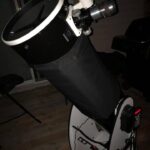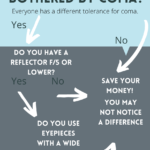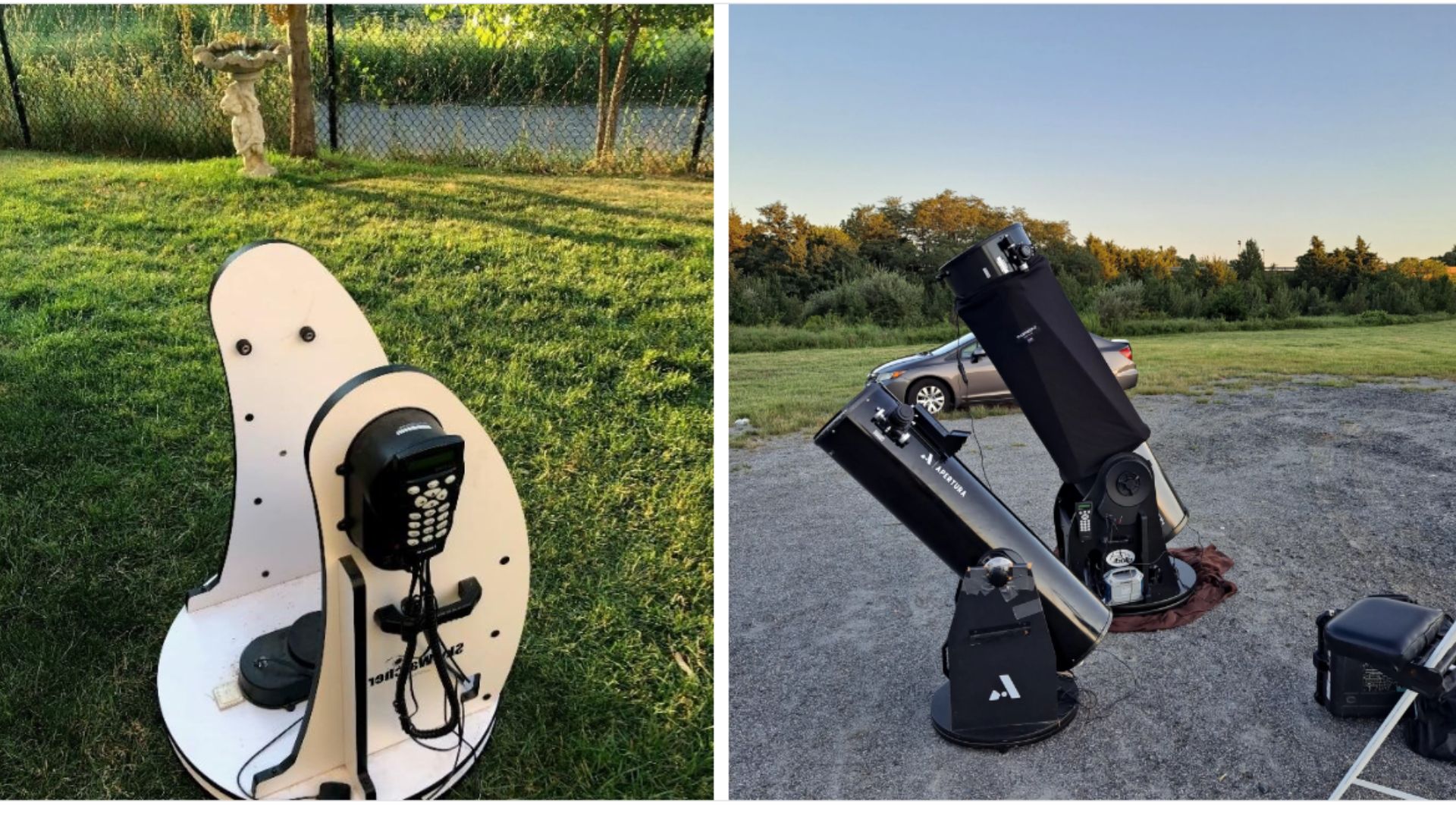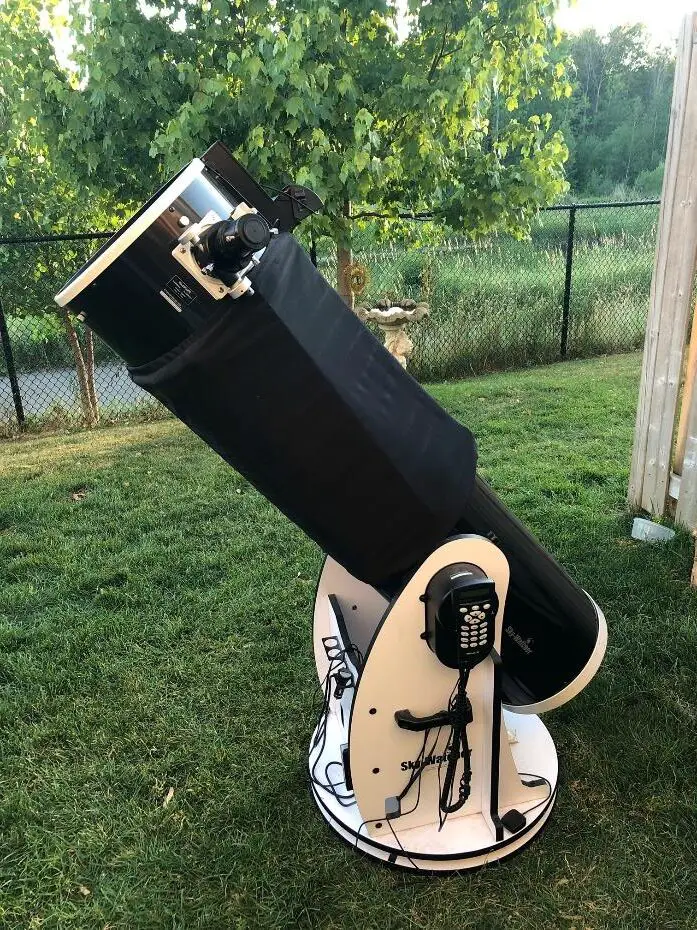A 10 Inch Dobsonian is a very capable telescope. You can find thousands of objects; galaxies, planets, globular clusters, double stars, and planetary nebulae even in light polluted conditions. If you are able to travel to a dark site, you will be rewarded with even more spectacular views.
While the exact objects you can see depend on the current weather conditions, time of year, eyepieces and humidity, you are sure to find some specular objects worth seeing.
If conditions are good and you are in the right time of year you can see:
Orion Nebula -M42 1344 light years away, the Orion nebula is an diffuse nebula where stars are formed. Orion is a great place to start as it is very easy to find. It is good with or without a filter and beautiful with a wide range of eyepieces. You may even be able to snap a good picture with your phone to show friends and family.
Terminator On the Moon – On any night where the moon is not full, you can see the line on the moon called the Terminator, this line causes the shadows of the craters to stretch and change shape. It is possible to get some very pretty photos of the moon by holding your phone up to the eyepiece. You may want to use a moon filter to dim the light from the moon if it is too bright to be comfortable.
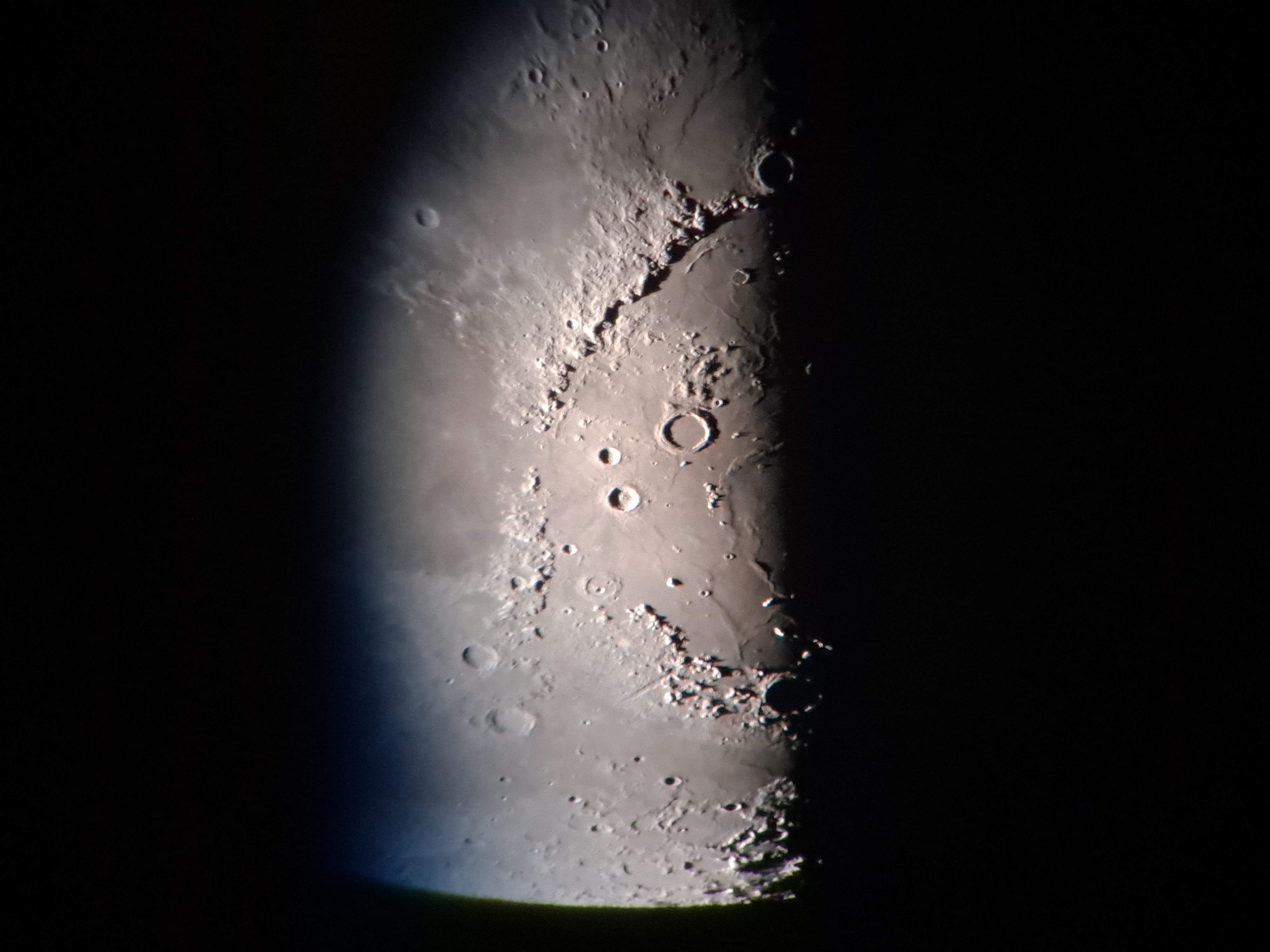
Omega or Swan Nebula – M17 is about 5,500 light years away. This is one of my favorite objects to find with my 10 inch. I prefer to use a nebula filter for observing this emission nebula. Stars are formed here.
Orion Nebula -M42 1344 light years away, the Orion nebula is an diffuse nebula where stars are formed. Orion is a great place to start as it is very easy to find. It is good with or without a filter and beautiful with a wide range of eyepieces. You may even be able to snap a good picture with your
Rings Of Saturn – You will clearly see the rings of Saturn and even see the division between the rings, called the Cassini Division. This is a memorable sight for everyone who sees it.

Red Spot or Clouds on Jupiter – Jupiter is a bright object which means that you may be able to make out more detail like the clouds or the great red spot. These are exciting sights as well. If conditions are exceptionally clear you may see a moon moving across the face of Jupeter. A moon and sky filter may help you make out more detail.
Orion Nebula -M42 1344 light years away, the Orion nebula is a diffuse nebula where stars are formed. Orion is a great place to start as it is very easy to find. It is good with or without a filter and beautiful with a wide range of eyepieces. You may even be able to snap a good picture with your phone.
Venus – Venus is really beautiful and when you know more about how to find Venus, and the mystery of the planet the more exciting it will be to see it with your own eyes.
Mars – With a 10 inch Dobsonian you can actually make out the surface detail of Mars. I was even able to see the polar ice caps on Mars on an exceptionally clear night. They look like big bumps on the poles of Mars. So exciting to see these things you have only read about.
Great Globular Cluster in Hercules – M-13 this very beautiful cluster of stars is the largest globular cluster that we can see in the Northern Hemisphere. With a 10 Inch Dobsonian you can make out individual stars. You can spend some time looking at this object. It is breathtaking.
This is a really exciting list and I am sure you are already looking up the next clear night. Please understand that there are a few factors to consider when you think about what you will be able to see.
Weather
When you are looking at the weather you should look at the dew point, cloud cover and transparency. The dew point is important because it tells you how much condensation you can expect to cover your mirrors and eyepieces.
The temperature should be as far away from the dew point as possible. This means less condensation or dew to interfere with your seeing. If the dew point gets too low you can use accessories to fight against the dew. Read more about active dew control in the linked post.
Cloud cover is important because your telescope cannot see through clouds. Your telescope is not the James Webb!
Seeing and transparency are measures of the stability of the gasses that make up the atmosphere. Imagine looking through hot air, you see the ripples that distort the image behind it. The gasses that make up the atmosphere can make it hard to see clearly into space. Very good transparency is less common and you should take advantage when you have excellent transparency.
Good seeing and transparency allows you to use higher power eyepieces.
You can use an astronomy weather app like ClearOutside or Astrospheric to help you evaluate the weather conditions for observing as well.
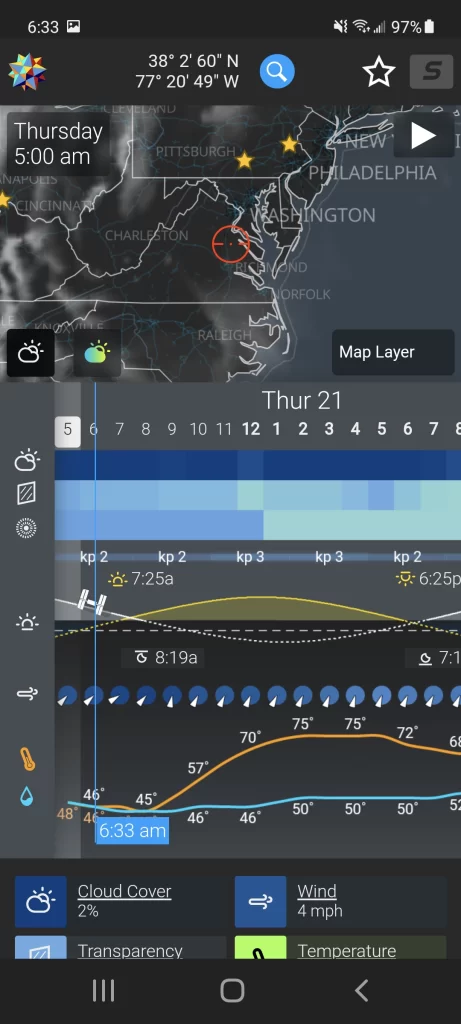
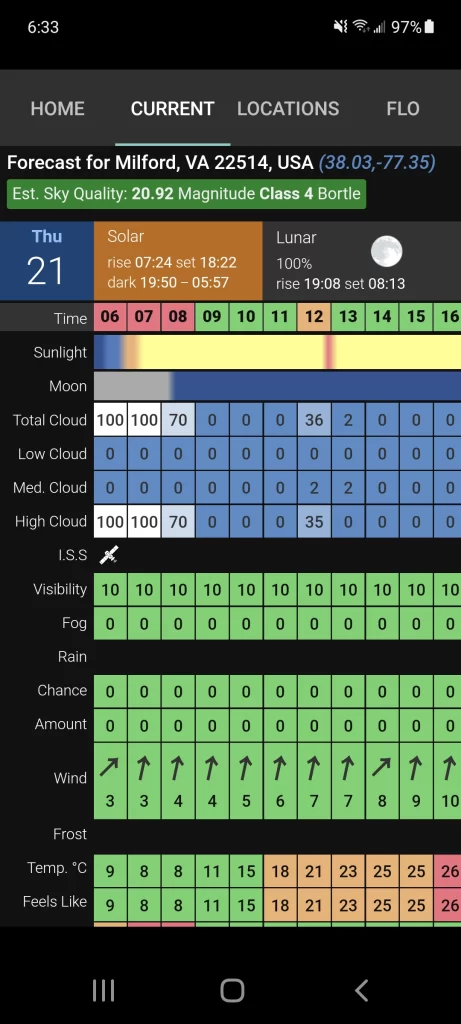
Light Pollution
You can find out the level of light pollution at your home by looking up the Bortle Scale. There are many places to find bortle maps, I like LPM or Light Pollution Map, and they are the measure of the darkness of an area.
While it is possible to see many many objects with a 10 inch Dobsonian in a light polluted city, traveling to a dark site will be memorable for any astronomer.
There are filters available that are supposed to reduce light pollution, but they say the best filter is a fuel filter! Meaning that the best way to beat light pollution is to drive to darker skies.
It is important to be patient as sometimes even in imperfect conditions a few minutes here or there of good seeing is not uncommon.
The more time you spend at the eyepiece the better, so don’t wait until you find the perfect spot to observe, but treat yourself occasionally to a weekend away from the city lights.
Eyepieces
The kinds of eyepieces that you use will also have a big effect on what you can see.
I recommend that you have a small collection of eyepieces but include at least one low power and one medium power. A 15mm and 30mm eyepiece should be great.
A wider angle eyepiece will allow you to see more in your field of view, I recommend 60-80 degrees. This will make it easier to see things as you explore the night sky by sweeping with a low power eyepiece then switching to a higher power eyepiece to see the object more clearly.
When I first started out in the hobby I would just slew my telescope across the sky until I came across something interesting. I would identify it by asking friends in my telescope Facebook group, but you can also use an app like Stellarium for identification.
It is a good idea to document your discoveries in some way. I know some people like to sketch, photograph or journal their findings. I use the simple notepad on my phone to jot down notes.
When you are ready to find things on purpose I recommend you grab Telrad or finderscope and a copy of Turn Left at Orion (affiliate link) and get reading.
This is the best beginner guide to the night sky. It will get you started on your own astronomy treasure hunt.
Can I see color with a 10 Inch Dobsonian?
In order to see color your eyes need light. So, you can see color in some very bright objects, but dimmer objects will appear black and white. Give your eyes plenty of time to become fully dark adapted to give you the best views possible.
The large aperture of a 10 inch Dobsonian allows you to see very bright images. Choosing the right filters and eyepieces can maximize the details you can perceive with your telescope.
While you should not expect to see NASA level multicolored spectacular images when visually observing, the thrill of seeing even the slight color visible with the naked eye is still very exciting.
You are likely to be able to see color in:
Saturn
Jupiter
Eskimo Nebula
Pleiades
Orion
Lagoon Nebula
You can read more about the best way to achieve dark adapted vision and some tips for seeing more color through your telescope in the linked post.
How Big is a 10 Inch Dobsonian?
These scopes are easy to travel with, even though they are pretty big telescopes. The size and weight of the scope is the price you pay for the large aperture that makes seeing so many dim distant objects possible.
There are several options when looking for a 10 inch Dobsonian telescope and they come in a range of sizes and weights. See if there is a reasonable scope that would fit in your car and that you could carry.
| Optical Tube Length | OTA Weight | Base Weight | |
| Apetura 10 Inch | 48.5” | 34.8 lbs | 31.4 lbs |
| Sky Watcher 10 Inch | 45” | 28 lbs | 25 lbs |
| Zhumell 10 Inch | 49” | 53 lbs | 7 lbs* |
| Orion 10 Inch | 47.8” | 30.8 lbs | 22.6 lbs |
*This does not seem right, but it is the information I found from multiple sources.
I had the 10 Inch Apetura Telescope and it was very easy to travel with and easy to set up. I am in my late 30s and I have had two spine surgeries and I had no trouble loading and unloading my scope multiple times a week. An observing chair was really helpful when using he scope.
I bought this telescope from High Point Scientific, and I highly recommend them as a company. I chose this telescope because it came with a good set of accessories: A moon filter, a right angle finder, laser collimator, 35mm extension tube and it had a Crayford Dual Speed focuser which is of high quality.
Out of the (very large) box it was an amazing first scope.
I would say that if you are going to be traveling frequently with your telescope this is about the largest solid tube I can recommend.
It just fit laying down across the back seat of my Honda Civic, but a 12 inch would not have fit.
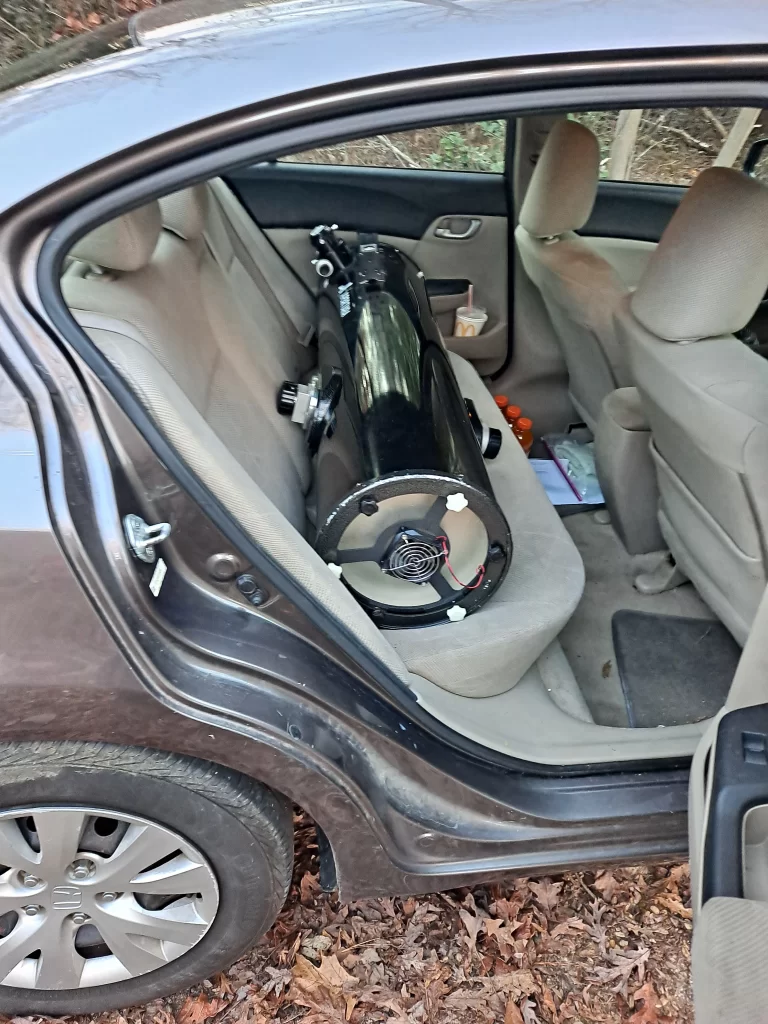
You can read more about how I travel with my Dobsonian in the linked post.
If you are looking for a more compact telescope, I would recommend a Schmidt Cassegrain. These telescopes use a different design to keep a larger aperture with a smaller and shorter optical tube. Read more about why we love Schmidt Cassegrain telescopes and how they work in the linked post.

